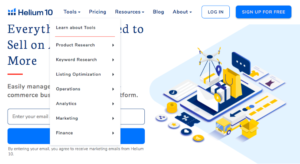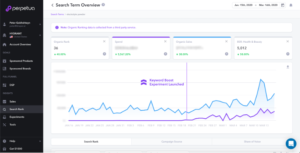
Software as a Service (SaaS) offerings have acted as a sort of valve in e-commerce, opening the floodgates to growth for millions of e-commerce sellers. As more and more SaaS providers start developing eCommerce tools, sellers have a wide variety to choose from, often across many different use cases.
Most eCommerce sellers today use multiple SaaS products throughout their business, creating a “software stack” rather than utilizing just one resource.
Choosing which software to use can be difficult not only because of the diversity of options but also because most sellers aren’t aware of what those options are until they come knocking on their email inbox. Choosing your SaaS stack takes a bilateral approach – first taking a 30,000-foot view of your business and its shortcomings, then choosing software that fits your needs, and always being open to alterations in that software stack depending on the new opportunities that arise.
Contents
The most popular SaaS options are those that provide a suite of services targeting many areas of business rather than just one. The best examples of these are Helium10 and Jungle Scout which assist with marketing, financing, operations, and analytics. Most sellers choose at least one service similar to this to use in their marketing strategy.

Software suites are great for assisting intro-level business optimizations like researching products, keywords, and basic listing optimization, and we highly suggest using them for anyone just launching on eCommerce platforms. There are a lot of highly rated software suites available to sellers, and the best way to choose is to read reviews, dive into their websites, and see which features differentiate one suite from its competitors. Most software suites also offer free trials or money-back guarantees, so you’re able to trial multiple before making your decision.
Though software suites are great for basic optimization, they provide less assistance for functions past the product launch period. After a product has launched, sellers should ensure that their listings are optimized, that they have set up effective PPC advertising, that their inventory is well managed, and that they have proper bookkeeping in place. To best optimize for these, it’s better to find software that focuses solely on these areas because they provide a more in-depth offering than a generic suite service.
That being said, you don’t need SaaS for every in-depth area. To best understand which SaaS services to include in your stack, it’s best to take a 30,000-foot view of your business.
Take a step back and look at the overall operation of your business. This means thinking about:
Looking at each of these will help you determine which areas you’re already operating efficiently and effectively, and which need improvement. You must be thorough in your business review because SaaS is available for every niche area, and citing just ‘advertising’ as your pain point won’t help you narrow down all of the advertising software options out there. Be as specific as you can in your pain points to save yourself time later.
Most times, the areas that you have the least expertise in are the most time-consuming and least optimized for. These are the most pertinent areas to seek out SaaS offerings and often end up boosting company growth the most because of just how much they bog down business operations.
Let’s use Amazon PPC advertising as an example. In a successful study conducted in 2020, Hydrant – a hydration brand – sought out SaaS because they lacked expertise in advertising. They were not only ranking below page 1 on Amazon’s search page for their best-performing keywords but also weren’t ranking for high-volume keywords that could gain them a lot of traffic.
Though Hydrant had tried running their PPC ads themselves, their lack of expertise was preventing further growth. It was not until they found Perpetua – a software offering focused on advertising – that they started performing well on their desired keyword, with share-of-voice increasing from 0 to 25 percent and organic rank improving by 40 percent.

It’s not that Perpetua takes over advertising for you. Most SaaS offerings don’t run your business for you and most sellers don’t want them to. They are created to assist through unique, expert-level tools that make that specific area of business easy to optimize and reduce the time needed to manage it.
Once you’ve decided which areas of business you need the greatest assistance in, you have to decide which SaaS you’d like to include in your stack to address those pain points.
The best way to do this is to look at the specifics found in your 30,000-foot analysis and research those first. Again, there are hundreds of agencies and software offerings willing to help with advertising, but if your weakness is accurately calculating ad spend, then software that targets that problem is the best option.
Once you’ve found multiple services that offer what you’re looking for (you likely will), look at their reviews and case studies to ensure the service performs well, and check their performance against their cost.
The last piece to narrowing down your SaaS decision is to look at the additional services offered by the company you choose. A lot of SaaS offerings usually are multi-functional within their specialty. Sticking with Perpetua as an example, they don’t have just a single advertising tool. They have multiple advertising-specific tools like Intelligence Reporting and Keyword Boost. Once you’ve narrowed down your search to just a few options, consider which additional tools will be most useful to you. If you have a lot of pieces to advertising you’d like to optimize, then this step will likely come earlier in your research process.
SaaS offerings are highly competitive and touch a lot of niche areas. That means there are a lot of lesser-known SaaS offerings out there that can be great additions to your stack despite not addressing one of the pain points you initially planned to address.
Many SaaS offerings address a need, and the customer often comes to them. If you know you need help with accounting, you will go looking for accounting software. But many more SaaS offerings provide services you may not have even known were available.
A good example of this type of SaaS is Seller Rocket. Seller Rocket provides sellers access to product recommendations from reputable publishers and provides sellers a database that tracks how many articles have been published that include their product, how many transactions each article has driven, and the share-of-voice that a particular article has (specifically for articles published directly to Amazon as an Amazon Editorial Recommendation).

Though many sellers who find out about Seller Rocket are eager to add them to their software stack, their niche position in the ecosystem and small platform makes it so most sellers don’t discover Seller Rocket unless they see one of their outbound marketing efforts. Services like this can bring you a highly competitive edge if appropriate for your products, but they address a more niche audience and can be classified as addressing a want, rather than a need.
Before committing to SaaS like this, it’s important to do proper research and ensure that the SaaS offerings that are flooding your inbox are going to make an impact on your business. That said, if you catch a new offering early, you can gain a major competitive advantage.
When considering small and niche companies, there’s less research to be done comparing similar platforms and more research to be done on that particular company. The best way to conduct this research is to:
Don’t let the size of a company deter you from considering their services. E-commerce is competitive and most small SaaS companies wouldn’t enter without confidence that their software is of quality, provides results, and differentiates them from the rest of the ecosystem. If you’re doing the right research and asking the right questions, you might walk away with the tool that pushes you and keeps you consistently ahead of your competitors.
Once you’ve chosen your SaaS stack, make sure that you’re tracking progress to ensure the stack is contributing to minimizing pain points and driving the business forward. If your SaaS isn’t working for you but has proven to work for others, meet with the company to understand why. Each SaaS team is made up of experts who have worked with the SaaS on a higher level and can provide expertise to determine why the SaaS isn’t working for you and assistance to help correct the shortcomings.
Now that you have your SaaS stack, treat it like a business partner. It’s there to optimize your time, optimize the areas you have less expertise in, and drive your business to success.

Maya Harper is the Seller Rocket Content Marketing Lead. Her focus is on developing meaningful partnerships and content for the Ecommerce ecosystem. You can contact her by emailing her at maya@sellerrocket.io or reaching out to her via LinkedIn.
© 2025 SellerRocket TM . All Rights Reserved.
Get our latest updates directly to your inbox.
Only the best in eCommerce and affiliate news, tips and tricks.
